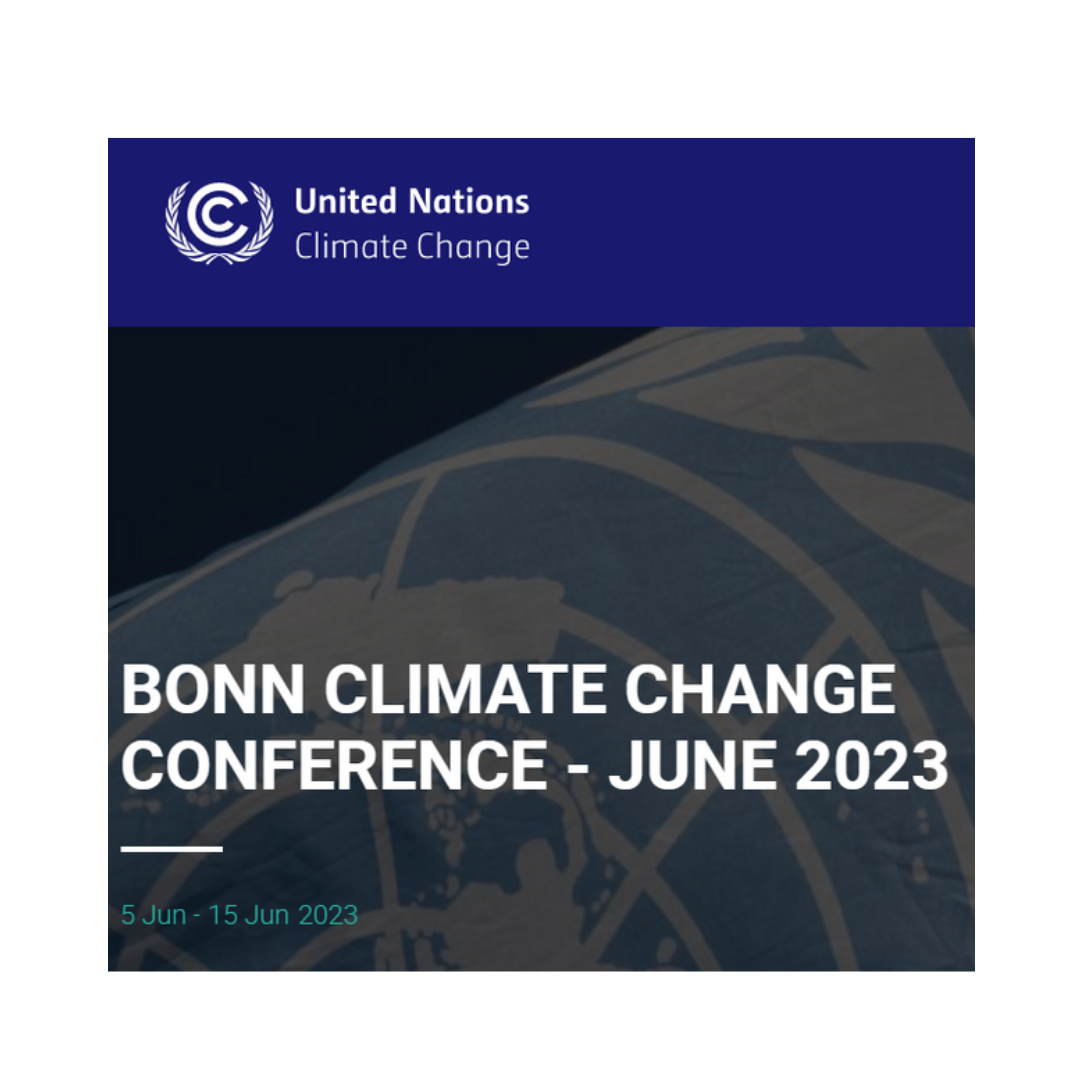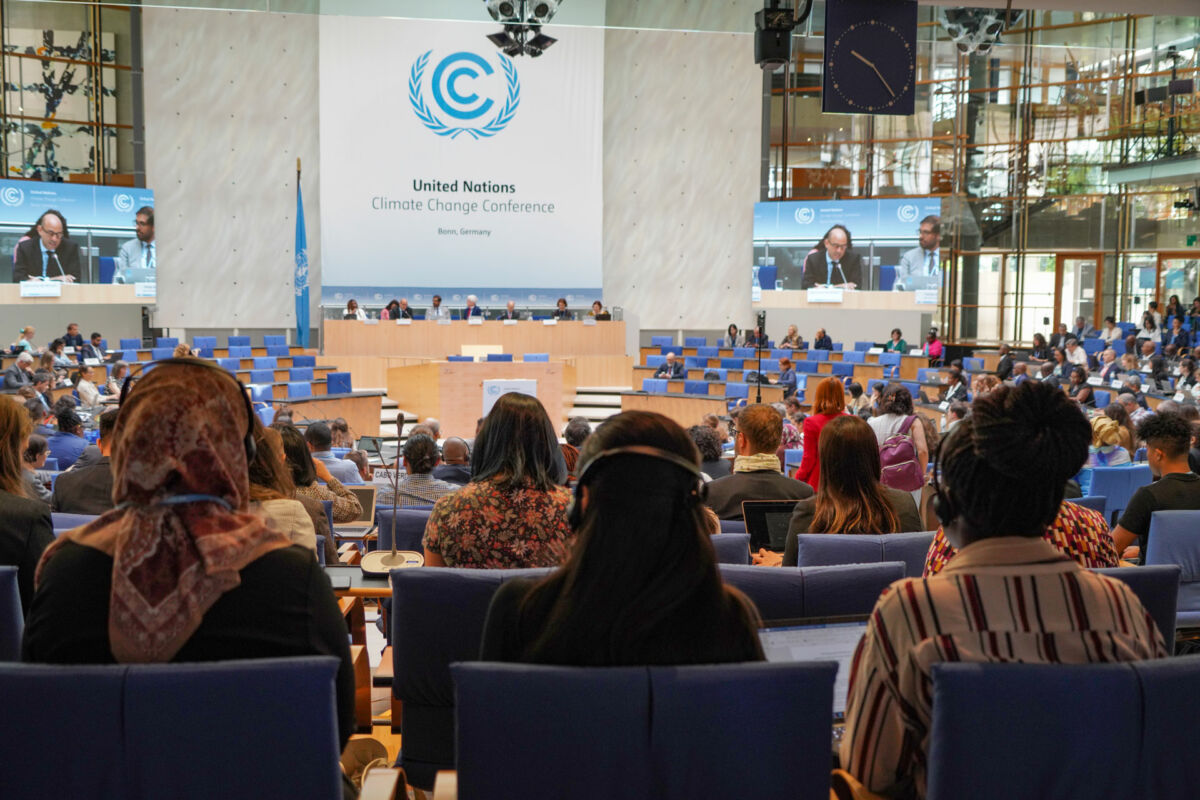SB58: From Sharm el-Sheikh to Dubai, Bonn is halfway
[July 2023] From 5 to 15 of June 2023, delegates from the whole world gathered at Bonn to follow up on decisions taken during COP27 and to prepare for COP28. On the agenda: the Global Stocktake of the Paris Agreement, adaptation, loss and damage, and a new climate finance target, among other subjects.

Analysis note by the Global Observatory of Climate Action
This note sums up the discussions of the SB58 in Bonn based on the following reports:
- Earth Negotiations Bulletin (19/06/2023). Summary report, 5-15 June 2023: Bonn Climate Change Conference – June 2023. International Institute for Sustainable Development.
- Gabbatiss, J. & Lempriere, M. (16/06/2023). Bonn climate talks: Key outcomes from the June 2023 UN climate conference. Carbon Brief.
- Authors : Clovis Grégoire, Intern of the Global Observatory of climate action, Tania Martha Thomas, Research Officer of the Global Observatory of climate action
- Date : July 2023
- Summary
- What were the stakes going in?
- Towards the conclusion of the Global Stocktake: What advances?
- Adaptation: Some progress despite blockages over financing
- Loss and damage: A hard-won victory yet to materialise
- Mitigations issues not relegated to the background
- Financing remains the heart of the matter
- What is at stake for COP28?

What were the stakes going in?
Following a COP27 in Sharm el-Sheikh that was stamped with stronger North-South divisions, and with plenty of discussions over loss and damage and historic responsibility; in the light of the last cycle of publication from the IPCC; and only months away from COP28 in Dubai where the first Global Stocktake of the Paris Agreement (GST) will be held, stakes were high for the 58th meeting of the subsidiary bodies (SB58)[1]. However the lack of agreement on subsidiary bodies’ meeting agendae, until the second-last day of the conference, cast a shadow over the negotiations.
The inclusion of the Mitigation Work Programme in the official agenda was one of the bones of contention. After its creation during COP26, Parties had agreed to launch the work on this programme, which aims to “urgently increase” the ambition and implementation of mitigation actions within the decade, at the following COP in Sharm el-Sheikh. Another object of disagreement was the demand from the group of the Like-minded Developing Countries (LMDCs)[2] to put on the agenda the issue of the increase of the financing.
The provisional agenda based on which the conference was held included questions related to subjects largely covered during the last COP: adaptation, loss and damage, climate finance, as well as a fundamental question for 2023 – the Global Stocktake of the Paris Agreement. Meanwhile, discussions also progressed on mitigation issues, such as just energy transitions or carbon markets.
Towards the conclusion of the Global Stocktake: What advances?
The first Global Stocktake will be held during the COP28, allowing us to see how much the world has progressed, where it needs to go and how to get there in order to fight climate change. As a core element of the Paris Agreement, the GST is conceived to orient the next cycle of climate commitments taken on the national level allowing countries to increase their ambitions if necessary. The first Technical Dialogue (TD) for the Global Stocktake was held during the previous Bonn negotiations in June 2022, the second during the COP27 in Egypt and the last one, held before COP28, happened at the 2023 Bonn Conference.
Discussions over the draft framework of the Global Stocktake which will be submitted to vote by the Parties at COP28 revealed diverging views over adaptation, mitigation, loss and damage, and means of implementation, but the most serious disagreements were over financial flows and the historic responsibility of developed countries. Discussions were concluded by the adoption of several text options for contested sections, which will be finalized during this year’s Conference of Parties in December.
A synthesis report of the third meeting of the Technical Dialogue on the Global Stocktake will be presented by the 15th of August 2023, and a factual summary report by the 8th of September 2023.
Adaptation: Some progress despite blockages over financing
Talks on adaptation at the Bonn Conference focused on 4 topics, and led to the following conclusions:
- Global Goal on Adaptation: The Paris Agreement calls for a global goal on adaptation to reinforce the global capacity to adapt, to build resilience and reduce vulnerability to climate change. While a work programme was launched at Glasgow for a two-year period aiming to set up a framework for the goal, which will be adopted during COP28, the discussions were slow, and the conclusion mainly focused on the structure of the goal.
- The Adaptation Committee: Created in 2010, in the context of the Cancun Adaptation Framework, the Adaptation Committee is one of the main organs of the UNFCCC working on this matter. Talks on the review of the committee were delayed as Parties disagreed on elements of the draft conclusion, thus leaving yet another decision to be taken during COP28.
- The Nairobi Work Programme: Established during COP11 at Nairobi, this programme aims to “catalyse the development and dissemination of information” to support policies and adaptation practices, particularly in developing countries. This year, talks in Bonn concentrated on the gaps in knowledge and adaptation efforts of countries. These discussions are closed until the next Bonn’s conference.
- National adaptation plan: National adaptation plans – established during COP16 in order to identify and work on adaptation needs over the medium and long term – were put on the agenda of the SB58 and adopted without any problem, unlike in the case of the Mitigation Work Programme. Discussions and informal consultations focused on the difficulties met by developing countries to set up these plans.
During the discussions, the sensitive point raised by the developing countries was the question of financing – climate finance flows towards adaptation are yet to reach the same level as towards mitigation.
Loss and damage: A hard-won victory yet to materialise
COP27 saw the long-awaited creation of the loss and damage fund destined to support the victims of the adverse effects of climate change, and the formation of a transitional committee in charge of developing the fund and other financing mechanisms to support practical measures. These actions have been largely considered as a victory for developing countries.
Present discussions focused on financing: where will it come from, how will it be distributed and who will benefit from it? Whereas developed countries wish to focus on financing through agreements outside the fund itself (via multilateral banks, insurances funds, humanitarian organisations…), developing countries want the fund to be created as an operational entity of the UNFCCC, financed by developed countries’ contributions in the form of subsidies (rather than loans, which must be reimbursed by definition).
In parallel, the Glasgow dialogue, established during COP28 as a compromise when a loss and damage fund wasn’t certain, held its second session in Bonn, with the mission to inform the transitional committee.
The only element concerning loss and damage which was the object of formal negotiations in Bonn was the question of the location of the Santiago’s network on loss and damage – the two options proposed were inside the United Nations Office for Disaster Risk Reduction (UNDRR) at Nairobi, Kenya or within the Caribbean Development Bank (CDB), located in Barbados. No consensus was reached, leaving the decision to be taken during COP28.
Mitigations issues not relegated to the background
Disagreements on the Mitigation Work Programme, mentioned earlier, and the “progressive phasedown” of fossil fuels – accepted during the last COP after hesitation to include the term “phaseout” – have been the object of heated negotiation.
The launch of a work programme on just transition pathways was a significant result of COP27. In Bonn, the main goal was to define the scope of application and the expected results. The work on the just transition finally fell into the same arguments used in many other negotiations – the necessity to increase the financial flows, because the move away from fossil fuels would be costly.
According to Carbon Brief, discussions about carbon markets as part of Article 6 of Paris Agreement entered a “deeply technical phase”, conclusions mainly focused on questions of procedure. The larger context was marked by controversies around carbon markets earlier this year, and the possibility of using carbon markets to channel climate finance towards developing countries. Subjects considered and discussed included: carbon credit trade, the potential right of a country to revoke the credits it sold, the way in which carbon removal credits should be counted, and emissions avoidance credits (which for now are not included in Article 6). The Article 6.4 Supervisory Body, created to establish rules for a new international carbon market, presented its recommendations on various controversial subjects.
Financing remains the heart of the matter
Whereas negotiations at Bonn were not, for the most part, directly and officially focused on finance, the question of money was raised in almost every exchange. A new “collective quantified goal” for climate finance post-2025, mandated by the Paris Agreement, must be agreed upon before COP29 in 2024. This objective must be also higher than the objective of 100 billion dollars which was set for 2020, but has not been reached. Talks tackled issues concerning the quantity of this objective and over the mobilization of new financing resources. Carbon Brief reports the general sentiment among delegates that the lack of sufficient financing is slowing down progress.
What is at stake for COP28?
The first Global Stocktake will without a doubt, be the “hot topic” of the COP28. The nomination of Sultan Al-Jaber, president of the national petroleum company of the UAE, could be considered surprising. However, the questions and legitimate fears that it creates must not hide the diplomatic agenda that follows its own path, COP after COP, independently of the succeeding presidencies. More than the Emirati presidency, the question of the access to finance for the South and solidarity from the North is increasingly affirming itself as the main obstacle to most issues.
NOTES
[1] The two subsidiaries bodies of the UNFCCC – The Subsidiary body for implementation (SBI) and the Subsidiary Body for Scientifc and Technological Advice (SBSTA) – assist the governing bodies, such as the COP.
[2] Representing over 50% of the world’s population, the LMDCs are group of countries that often act as a bloc in international negotiations.


